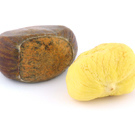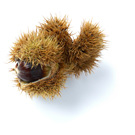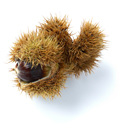Chestnut Trees for Sale
The mighty Chestnut tree grows from 50 to 100 feet tall and can average up to 5 feet in diameter when fully mature. The mature heights of our nut trees for sale will vary from the smallest species of Chinquapins, often shrubby, to the giant tree of past American forests. Chestnut trees once dominated the forests of North America but were nearly wiped out by a devastating pathogenic fungus chestnut blight brought into the US in 1904. It took approximately 40 years to wipe out 40 billion Chestnut trees leaving behind few standing groves in Michigan, Wisconsin, California and the Pacific Northwest.
The Chestnut Tree, a tree of antiquity has been found from Sardis in Asia Minor to all portions of Europe, the mountainous Mediterranean, Southwest and Eastern Asia and North America. The first known plantings of chestnuts were discovered around 2000 BC. The Chestnut genus Castanea, belongs to the family Fagaceae, which also includes ash and beech trees.
Willis Orchard Company has deciduous nut bearing chestnut trees for sale that require a partner tree for pollination in your orchard. The sweet nuts ripen in the fall of the year and are excellent for roasting or candied. As well as being consumed fresh, chestnuts can also be canned, pureed, or preserved in sugar or syrup. Nutritionally, chestnut fruits are considered a carbohydrate that contains very little fat, mostly unsaturated, and no gluten. Fresh chestnuts have less calories than walnuts, almonds, other nuts and dried fruit.
The Castanea does not grow well on alkaline soils and prefers a pH range 5.5-6. It grows best in a soil that has good drainage with adequate moisture and the tree prefers sloping, deep soils and soils derived from granite and sandstone; it also does not like shallow or heavy soils with impermeable clay subsoils. The Chinese chestnut prefers a fertile, well-drained soil, but it can grow well in fairly dry, rocky, or poor soils.
For optimal growth on saplings and smaller trees, plant in full sun. Planting with wide spaces encourages low, broad canopies with maximum exposure to sunshine to increase fruit production. Closer planting gives a quicker short-term production but heavy pruning and possibly tree removal may be required later.
Chestnuts produce a better crop when subjected to chill temperatures during the dormant season. It is hardy to zone 5 and a mature tree is not bothered by cold rains or snowfall. Late frosts can be damaging to young buds and new young growth is susceptible to frost damage even on mature trees.
Our chestnut trees for sale do well with natural rains and drip irrigation at the drip line to about 32 inches per year. Once established, they are drought resistant. A 2-to-4 inch layer of mulch can help prevent wide soil temperature fluctuations. Apply materials such as shredded bark, pine straw, or typical wood chips in late November, after the chestnut plants are fully dormant and the soil is cold.
Willis Orchard Company offers a fine selection of hardy chestnut trees to buy for the home orchard. Native American chestnuts that resisted the blight have also been discovered and are being offered as seedlings.
Our chestnut tree varieties include the American Chestnut Castanea Dentata with some species called Chinquapin or Chinkapin Castanea pumila, Chinese Chestnut Castanea mollissima and two grafted hybrid varieties, the Colossal and Nevada. Let us assist you with your Chestnut Tree selection.



